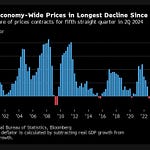TLDR: There’s always a bailout. Last night the Bank of England was forced by a spiralling series of ‘doom loop’ margin calls on British pension funds to intervene with a promise to print at least another £68b to buy Government bonds in order to stabilise the market.
Ironically, that’s more than enough printed money to pay for the £45b of tax cuts for Britain’s richest that turbo-charged the turmoil in the first place. The move appears to have stabilised British and wider global financial markets for now, but flies directly in the face of the central bank’s plans to unwind its money printing and hike interest rates to control inflation. It only makes sense if the newly-appointed Conservative Government of PM Liz Truss reverses its plans for debt-funded tax cuts for the wealthiest.
The moves also undermine whatever is left of the Bank of England’s credibility and calls into question again the role of central banks in an era where their independence and powers to print money to intervene in financial markets have consistently been used to protect the wealthy from the risk of collapse and often further enhanced their wealth. This is at the expense of those without assets who rely on wages that are being eaten away by inflation and are paying rents to those same wealthy asset owners.

Another central bank intervention to protect the wealthy
The Bank of England intervened in British bond markets overnight to reverse its Quantitative Tightening1 and promise unlimited money printing to stop a 'doom loop' that threatened to take down £1.5t worth of defined benefit pensions schemes.
For those familiar with central bank actions since 2007, this is another intervention to stabilise financial markets that effectively sees independent officials use an arm of the state in a way that makes the richest taxpayers even richer, while ensuring that any losses are socialised to taxpayers at large. It is the definition of a captured state being weaponised to make the rich richer and the poor poorer at an enormous scale and at a rapid pace.
Here’s the Bank of England’s statement last night (bolding mine), which followed the worst collapse in British Government bond prices in modern history after new PM Liz Truss and her Chancellor of the Exchequer Kwasi Kwarteng announced tax cuts for the rich funded by government borrowing that financial markets thought was not credible:
“This repricing has become more significant in the past day – and it is particularly affecting long-dated UK government debt. Were dysfunction in this market to continue or worsen, there would be a material risk to UK financial stability. This would lead to an unwarranted tightening of financing conditions and a reduction of the flow of credit to the real economy.
“In line with its financial stability objective, the Bank of England stands ready to restore market functioning and reduce any risks from contagion to credit conditions for UK households and businesses.
“To achieve this, the Bank will carry out temporary purchases of long-dated UK government bonds from 28 September. The purpose of these purchases will be to restore orderly market conditions. The purchases will be carried out on whatever scale is necessary to effect this outcome. The operation will be fully indemnified by HM Treasury.” Bank of England statement.
It then detailed the initial round of money printing in another statement, saying it would buy at least £5b of long-dated bonds each trading day until October 14.
The Push-Me-Pull-You central bank vs itself and its own Government
This extraordinary intervention means reversing the Bank of England previous stance of having to tighten monetary policy to control inflation of nearly 10% in the face of a reckless loosening of fiscal policy.
Just imagine a firefighter pouring foam onto a fire that the home owner is pouring petrol onto, and then the firefighter reconnects the hose to the diesel tank on the fire engine and starts pumping that diesel onto the fire. It is pure madness, particularly if Truss and Kwarteng don’t back down and give up on their plans for £45b of tax cuts that will mostly go to the already-rich. For example, Britain’s top 2,500 taxpayers will receive tax cuts averaging £18m each from the package.
The irony should not be lost on anyone that this resumption of money printing to buy Government bonds will worsen the inflation that is hurting wage-earning renters the most, and the act of inventing money to buy the bonds will see that money go from a spreadsheet cell at the Bank of England straight into the savings accounts of those wealthiest taxpayers. That will leave taxpayers at large with a Government debt that in theory has to be repaid (assuming the Bank of England doesn’t just cancel the bonds it has), just so pension fund owners don’t have to take losses and just so the richest receive a tax break, which in theory would eventually trickle down to the poorest, but which doesn’t, as decades of research from the IMF, OECD et al have proven.
It is the definition of a captured state engaging in sociopathic behaviour that socialises the losses of a financial crisis while protecting and enriching the already-rich. The Bank of England is effectively being used as a tool to transfer wealth from the poor to the rich, and to transfer risk from the wealthy to the poor.
The obvious point is that it’s not that different to what our own Reserve Bank, along with many most other developed world central banks, did in spades during the Covid Crisis. The next question being asked in US financial markets is how long before the US Federal Reserve is forced to do the same again. Treasury Secretary Janet Yellen was forced to reassure financial markets overnight that US bond markets were functional and the United States was not in the same situation. Stock markets rallied in anticipation of the bailout to come.
So how did this all go so pear-shaped so fast?
Luckily for me2, I spent time working as a financial reporter for Reuters and the FT Group in the early 2000s so I hope I can understand and explain what just happened to a wider audience. Part of my job in the City of London was to cover banks, insurers, pension funds and bond markets. I was up to my neck in pension fund reports, Bank of England statements, gilt market reports and insurance sector mergers for a couple of years. Fun times.
So I’ve spent the last couple of hours delving into the bowels of how Britain’s financial markets have been operating in recent years to understand why the Bank of England felt it had to destroy its own monetary policy direction to protect the financial stability of the nation, effectively sacrificing one of its core aims (keeping inflation low) in the short term to serve it’s other core aim (keeping financial system stability) in the short term.
This is all about Britain’s defined benefit pension funds and how in recent years they started using a derivative called a ‘Liability Driven Investment’ (LDI) to protect themselves against falling interest rates. For those unfamiliar with defined benefit pensions because we don’t have many left in Aotearoa-NZ3, they were an old-fashioned style of pension for long-term employees that guaranteed to pay them a certain portion of their final salary as a pension after they retired until they die. That all sounds sensible until you put together the combination of ever-aging pensioners and the long-term fall in interest rates and investment returns.
It meant that in the late 1980s and early 1990s, it dawned on large companies and Governments that these schemes were ruinous and would leave Governments and companies on the hook for massive unfunded liabilities over the long run. So many have been closed to new contributors and most pensions are now defined contribution schemes, where the saver bears the risk of a drop in market returns. These ‘DB’ schemes were very popular in the UK and have been mostly closed to new contributors because it is an extremely sweet deal for pensioners. It is one of those amazing examples of inter-generational wealth transfer. These funds currently have around £1.5t in them, which is worth about two-thirds of GDP and equal to the size of the entire UK gilts market. So when these funds move, everybody quakes in Britain’s financial markets.
On the face of it, rising interest rates should be a good thing for the valuations of the liabilities in these funds because the valuations are done by using interest rates as a discount rate to calculate a net present value of the fund. The higher the discount rate, the lower the value of the unfunded liability. But the problem is the managers of these pension funds have tried to insure themselves against having to report big upward or downward movements in the values of these unfunded liabilities, which in some cases have forced pension authorities to intervene, and in the worst cases forced companies out of business.
Surprise, surprise. It’s all about a fancy new derivative…
The way to insure yourself against big moves in interest rates is to buy a derivative, which insures you don’t lose big if interest rates fall in a big way. That means these defined benefit (DB) schemes are betting that interest rates won’t fall much, and certainly not rise much. When they do rise dramatically, as has happened this year and in an extraordinary way in the last week, these funds have to put up collateral to back their ‘bets’. The players on the other sides of these bets with LDIs are the likes of BlackRock, Legal & General, Columbia Threadneedle, Insight Investment and Schroders.
Here’s Toby Nangle, who used to head up asset allocation at Columbia Threadneedle, explaining here overnight in the FT (bolding mine):.
"When fixed rates rise, the mark-to-market of your long fixed rate swap position falls. And your excess collateral buffer is reduced. It probably needs replenishing at some point. Maybe immediately. Like right now.
“And if you simply can’t replenish it and triggers are hit, your counterparty might simply liquidate all the collateral you’ve posted and close the position. And what eligible collateral do pension schemes hold a lot of as part of their efforts to liability match? Long gilts. Lots and lots of long gilts.
“And that seems to be what has happened in recent days. Margin calls have forced pension plans into dumping long gilts, sending yields spiralling and triggering a new round of margin calls - a classic feedback loop.
It looks to me as though this gilt market-hammering doom loop of margin calls and rising gilt yields triggering more margin calls is what has caused the Bank of England to depart from its “quantitative tightening” programme and engage in long-end QE today” Toby Nangle in FT
Here’s another good explanation of the chain of events below in a tweet thread from Dan Mikulskis, an actuary, and here’s explainers via Reuters, Bloomberg-$$$ and FT-$$$4.


So how big could the margin calls be?
A UK regulator estimated in 2019 that the total notional value of DB schemes’ leveraged investments (LDIs) was £498.5b, which is about a fifth of UK GDP. The leverage levels inside these schemes was anything up to seven times liabilities. Others have estimated the risk at around £380b. Oy vey.
No wonder the Bank of England intervened. This sounds awfully similar to what we saw in 2008/09 when lightly-capitalised US banks created leveraged derivatives based on loans in the US mortgage bond markets and didn’t expect mortgage defaults. When the bets on these credit default swaps (CDS) on (CDOs) collateralised debt obligations went badly wrong, those institutions on the wrong side of the bets such as Lehman Bros and AIG (who have previously profited hugely from these bets) got caught in those leveraged collateral call doom loops. They didn’t have big enough buffers to survive. Lehman Bros was allowed to fail, but the ensuing carnage meant the US Federal Reserve had to bail out the global financial system within days by rescuing AIG5. If you weren’t around at the time, I’d recommend watching or reading The Big Short.
Here’s a quick video clip from the movie that explains it well.
No bankers paid the price from 2008. Few will again this time.
The crushing conclusion from the The Big Short was that a captured financial system used the arms of the state to socialise the losses from reckless behaviour and made the rich even richer. But no one paid the price. Very few handed back their bonuses. Justice was never done, or seen to be done.
Yet here we go again.
There was never a reckoning from the Global Financial Crisis. Voters were never able to intervene to impose justice by jailing bankers and allowing asset owners to take massive hits to valuations. Instead, central bankers were seen as the ‘grown-ups’ and technocrats able to move fast to rescue economies while politicians squabbled. The banks themselves used shareholders’ cash to pay settlements. Only a handful of the most junior players ever saw jail time. Few of the big swinging bankers that caused the crisis ever repaid their bonuses.
Voters and elites should have intervened then to remove those powers from central banks and strip them of independence to avoid it happening again, and to remove the now massive moral hazard built into the global financial system and asset prices.
Independent central banks actually amplified their bailouts during Covid to stop financial markets slumping and bond markets freezing up. The Reserve Bank of New Zealand started doing the same thing at scale in March of 2020, removing LVR restrictions and printing $55b to lower long term interest rates. That unleashed a 45% rise in house prices, delivering hundreds of billions of dollars worth of (untaxed) house price gains to Aotearoa-NZ’s homeowners.
So what happens now?
The expectation is that Kwarteng and Truss will have to back down and that the Bank of England’s intervention gives them time to back track.
Here’s the FT-$$$ again (bolding mine)”
“A temporary intervention is unlikely to hold down gilt yields for long unless the government changes tack on its tax-cutting plans, said Mike Riddell, a bond portfolio manager at Allianz Global Investors.
But if investors get a sniff that Wednesday’s move is the start of a longer-lasting intervention in the gilt market, they may start to doubt the BoE’s commitment to acting aggressively to tame inflation, which chief economist Huw Pill signalled on Tuesday.
A more extended period of BoE bond buying would certainly help gilts, but probably spell a further decline for the pound.
“This is extraordinary,” said Riddell. “The BoE told the market yesterday that it was going to be very hawkish, now today it’s buying gilts again. What is initially seen as temporary can often become permanent. If that looks like the case, sterling could be in trouble.” FT-$$$
We’ll see. If this crisis keeps cascading into the global financial system, then we could be in for some sort of repeat of 2008/09. It’s a lot like watching a car crash in slow motion. Or even worse, a re-run of the same car crash from 14 years ago.
Sadly, the smart money is now gearing up to get in on the next bailout. That’s why the S&P 500 closed up 2% this morning and the US 10 year Government bond fell 22 basis points to 3.74%, having earlier touched 4% shortly before the Bank of England’s intervention.
Paying subscribers can see more and hear more detail and analysis below the paywall fold and in the podcast above.
Elsewhere in the news overnight
Undersea gas explosions - The European Union vowed to protect its energy infrastructure after saboteurs, suspected to be Russian, blew up the Nordstream 1 and 2 pipelines in the Baltic Sea. It ended any hope of a resumption of Russian gas supplies this winter and forced gas prices up 11% overnight; Reuters;
Bailout celebration - US and UK stocks and bonds rallied overnight after the Bank of England pledged to print £5b per day for 13 days straight to drive down long-term gilt yields. The NZ dollar bounced as well as risk appetites returned to global markets. Reuters;
‘Here’s our dollars’ - The United States held a summit for Pacific Island nations overnight in Washington, pledging ‘big dollar’ help to stymie China’s growing influence in the region Reuters;
IMF calls out British recklessness - The IMF warned Britain against its unfunded tax cuts for the rich in an unprecedented criticism of one of its biggest members, and harking back to its humiliating intervention in 1976 to bail out Britain; IMF and,
Te Pāti Māori President and Whānau Ora and Te Whānau o Waipareira CEO John Tamihere attacked the NZ Herald and NewstalkZB overnight in an Op-Ed on Waatea News responding to Matt Nippert’s report in the NZ Herald-$$$ yesterday that the Charities Commission was investigating nearly $500,000 in charitable funds being loaned to Tamihere for his political campaigns. Richard Harman reported via Politik-$$$ this morning that Tamihere told party members last night not to talk to NZME outlets again.
Some fun things

Ka kite ano
Bernard
PS: My apologies for not delivering an email yesterday. I got bogged down at a conference and ran out of steam. But back on track today. I hope this deeper dive was useful.
Quantitative Tightening is the opposite of Quantitative Easing, in that it is the ‘unprinting’ of money previously used to buy Government bonds. It is done by selling the bonds back to the market.
Ha!
For example, the Government Superannuation Fund is just such a defined benefit scheme. It was set up in formally in 1956 and inherited a bunch of such defined benefit pension schemes for state employees. It was closed to new members in 1991, but there are still nearly $1b a year of payments going out to over 43,000 members, with just over 4,000 people still contributing. The fund manages $5.3b in assets and has an unfunded liability of about $6.8b. The Government essentially has to pay this out of its general revenues. It is the sweetest deal for those still in the scheme and is effectively making tomorrow’s taxpayers pay for an ‘extra’ pension for state employees.
This is a gift link from me as an FT subscriber to you as a subscriber to The Kākā. It will work three times. If it’s used up, give me a yell in the comments.
Remember the All Blacks main sponsor for years?. Yeah. That AIG.














Share this post